The Beginner’s Guide: Don Hertzfeldt, Animator, Writer & Director
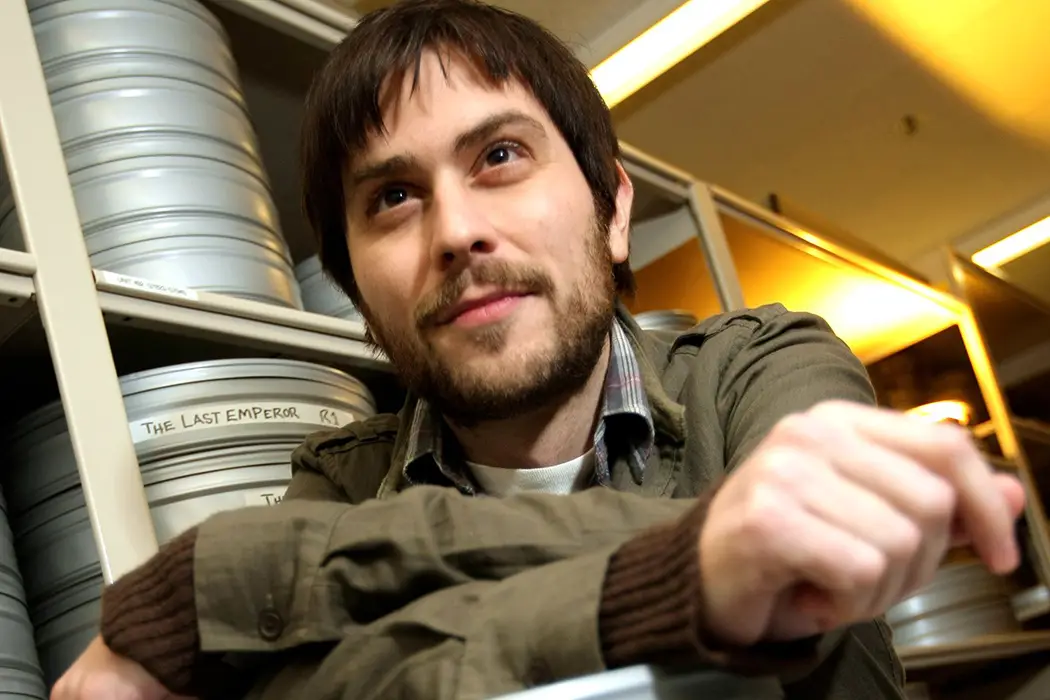
Alexia (also known as Lexi) spends an alarming amount of…
When discussing the most influential animated films, people’s minds tend to gravitate toward works produced by Walt Disney Animation Studios, Pixar, Studio Ghibli, and DreamWorks, among others. However, one of today’s most imaginative and inspiring animators is producing award-winning films without the help of a major studio. That animator’s name is Don Hertzfeldt, and he also writes, directs, produces, and performs the voice acting for his films.
Don Hertzfeldt, the son of a county librarian and an airline pilot, was born on August 1, 1976 in Fremont, California. He developed a passion for drawing at an early age and started attending Spike and Mike’s Festival of Animation in San Francisco, where he was introduced to early short films from Mike Judge, John Lasseter, Nick Park, and Bill Plympton. By age 15, he got a small camera and started teaching himself how to do frame-by-frame animation. In an early interview, he admits to be known as “that weird guy who makes the cool cartoons” during his time at Mission San Jose High School.
Not wanting to shoot live-action films that would look low-budget, Hertzfeldt realized that animation gave him full control over his work, and didn’t require a big crew or a ton of money. Hertzfeldt went on to study film at the University of California, Santa Barbara. His career began with a laudable batch of student films and skyrocketed from there. He may not be a household name like some filmmakers, but Don Hertzfeldt has acquired a substantial following; and after diving into his filmography, it certainly isn’t difficult to see why.
Ah, L’Amour (1995)
During his freshman year at UC Santa Barbara, Hertzfeldt produced his first short film, Ah, L’Amour. This two-minute 16mm film eventually became a cult film and won the HBO Comedy Arts Festival’s Grand Prize Award for “World’s Funniest Cartoon” in 1998. The film features “poorly-drawn stick figures”, which has since become one of the hallmarks of Hertzfeldt’s filmography. It also features a soundtrack that consists entirely of guitar music, which Hertzfeldt performed himself.
In Ah, L’Amour, the male protagonist approaches several women, who react with excessive violence. The film is meta in the sense that it is being told from the vantage point of a “bitter” filmmaker, who crumples up the paper he’s drawing on after his main character is subjected to violence. The meta-humor and self-parody elements of Ah, L’Amour have become recurring themes throughout Hertzfeldt’s filmmaking career. Ah, L’Amour is an impressive student film and Hertzfeldt is able to accomplish a lot in a matter of two minutes without any verbal dialogue.
Genre (1996)
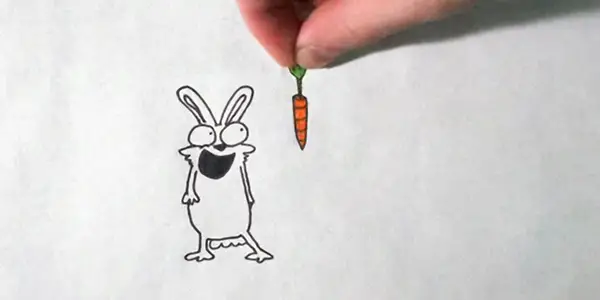
His second student film, Genre reveals just how rapidly Hertzfeldt’s filmmaking skills developed over the course of a year. Genre combines live-action and animation, adding another level to the story’s meta-humor. The film begins with an animator sitting at his desk, drawing a rabbit on a piece of paper. The nameless rabbit is being controlled by the animator, sometimes with the animator’s hand physically interacting with the two-dimensional drawing. Genre then follows the rabbit as he is drawn into a variety of different film genres such as romance, science fiction, comedy, and more.
Genre serves as a hilarious commentary on movie formulas and genre tropes, tackling nearly the entire spectrum of genres in a runtime of just under five minutes. The film is noteworthy for its combination of live-action, stop-motion, and hand-drawn animation. This combination of artistic mediums is something Hertzfeldt has explored in several of his films and is one of many reasons why he’s one of the most creative filmmakers working today. Not only does Genre have a meta angle to it since Hertzfeldt himself appears in the film as the animator, but the film also demonstrates his proclivity for self-parody. Hertzfeldt’s ability to mock himself in his work is part of the charm of his films, and Genre is no exception. The film received 17 awards despite the fact that Hertzfeldt cites it as his least favorite of his filmography.
Lily and Jim (1997)
While he was a junior in college, Hertzfeldt produced a 13-minute short film titled Lily and Jim. This short was a technical achievement that took a year and a half to produce with production facing numerous hurdles along the way. He initially shot it as a live-action film with improvised dialogue before drawing his stick figure characters and animating them to sync up with the dialogue. Aardman Animation’s short films helped teach Hertzfeldt the art of lip-sync animation.
Lily and Jim takes an honest look at the awkwardness of a blind date. The film has a documentary style where the titular characters speak as though they are being interviewed. There are long pauses and uncomfortable silences as the film fully embraces the awkwardness and anxiety of dating. The film also explores the pressure to make a good first impression as well as the misunderstandings that can occur as a result. Lily and Jim eventually went on to win 25 awards.
Billy’s Balloon (1998)
The film that marks the end of his college career is Billy’s Balloon, which is Hertzfeldt’s first short to be nominated for the Short Film Palme D’Or at the 1999 Cannes Film Festival. He was the youngest director in the competition that year. Despite not winning at Cannes, the film has received a total of 33 awards to date, including the Grand Jury Award at the 1999 Slamdance Film Festival.
Billy’s Balloon is often considered a dark parody of Albert Lamorisse’s 1956 short film The Red Balloon. Hertzfeldt’s short has no dialogue and plays out like a silent film. The story revolves around a stick figure being repeatedly attacked by a red balloon. With Billy’s Balloon, Hertzfeldt really perfected his signature minimalist style.
Rejected (2000)
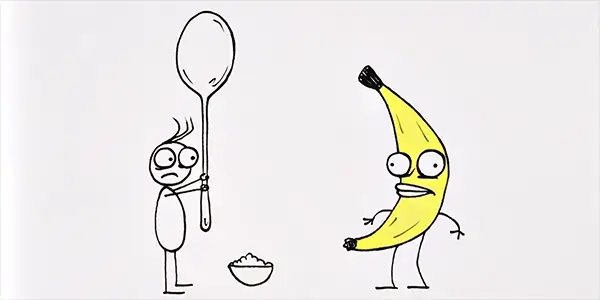
Hertzfeldt’s biggest claim to fame comes in the form of his Academy Award-nominated short film, Rejected. Plenty of people who have never even heard of Don Hertzfeldt have seen Rejected because it became somewhat of an Internet sensation. The film developed a cult following thanks in large part to its absurd humor and quotable one-liners such as “my spoon is too big” and “I am a banana” among others.
With Rejected, Hertzfeldt takes self-parody to another level by making himself a character in the film. The film tells the story of how the fictional Family Learning Channel commissioned animator Don Hertzfeldt to create promotional segments for their network. Not only is Rejected Hertzfeldt’s most well-known film, but it also captures the unique themes that the director has become known for such as hand-drawn stick figures, minimalist animation, graphic violence, dark themes, surrealism, and meta-humor.
The film premiered at the 2000 San Diego Comic Con. The following year, it was nominated for an Academy Award. Following in the footsteps of the film’s title, Rejected lost to Michaël Dudok de Wit’s Father and Daughter. Nonetheless, Hertzfeldt’s short won 27 other awards.
The Animation Show (2003)
In 2003, Hertzfeldt directed a “trilogy” of short films for the first year of the Animation Show festival. His shorts—Welcome to the Show, Intermission in the Third Dimension, and The End of the Show—served as the bookends and intermission for the collection of shorts.
These three shorts served as a fun side project for Hertzfeldt while he was in the middle of producing The Meaning of Life (2005). No computers were used in the process (as is the case with Hertzfeldt’s other films) but this trilogy features some more experimental animation. Hertzfeldt experimented with double exposures, stop-motion hybrids, and a variety of shadow and lighting effects.
The Meaning of Life (2005)
The dark humor in Hertzfeldt’s work could almost be seen as foreshadowing for his later projects, which were much deeper and philosophical. His serious films are still dark and still maintain some element of humor, but Hertzfeldt began exploring abstract themes, such as the meaning of life. Hence, it’s no coincidence that in 2005 he released a 35mm short film titled The Meaning of Life.
The Meaning of Life was in production for nearly four years and consists of tens of thousands of drawings, all of which Hertzfeldt drew himself. The film traces the evolution of the human race in a way that only Hertzfeldt could conjure up. In a review for The Atlanta-Journal Constitution, Bob Longino refers to The Meaning of Life as “animation with intention that goes far beyond amusement. It jogs the brain, reaching deep to conjure up thoughts about the nexus of existence. More simply, it’s the closest thing on film yet to Kubrick‘s 2001: A Space Odyssey.” While dozens of science fiction films have been compared to 2001: A Space Odyssey, Hertzfeldt’s work is more deserving of the comparison because of the way in which he delves into and explores such profound themes.
Wisdom Teeth (2010)
In 2010, Hertzfeldt released another absurd comedic short titled Wisdom Teeth. The film isn’t in English, but the language is one that Hertzfeldt made up for the film. However, the film does include English subtitles.
Wisdom Teeth is about one friend helping another friend pull his wisdom teeth out. It’s a simple premise, but in the film’s brief runtime it manages to go in a very unexpected direction (as one would expect from Hertzfeldt at this point in his career). Comparable to Rejected, Wisdom Teeth is a sick and twisted little film that’s weirdly humorous.
It’s Such a Beautiful Day (2012)
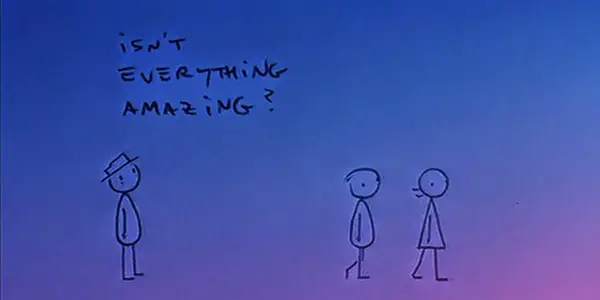
Hertzfeldt’s first feature-length film (clocking in at a mere 62 minutes) is the combination of three of his previous short films: Everything Will Be Ok (2006), I Am So Proud of You (2008), and It’s Such a Beautiful Day (2011). The three shorts serve as chapters in the feature-length film, which shares the same name as the final chapter.
It’s Such a Beautiful Day (2012) is an experimental animated film, a black comedy, and a heart-wrenching drama. The film beautifully combines live action photography with its minimalist animation, while also effectively using color in contrast to its largely monochromatic color scheme. With It’s Such a Beautiful Day it becomes clear why Hertzfeldt’s minimalist animation style works so well—the visual minimalism is balanced out by the film’s heavy subject matter and immense philosophical themes.
The film explores themes of love, loss, family, identity, memory, and the meaning of life itself. The story follows a top-hat wearing stick figure named Bill, who is suffering from an unnamed illness that impairs his mental health and causes his memory to fail. Hertzfeldt narrates the film and walks us through Bill’s daily life as well as his struggles with his condition. Bill is the perfect everyman, and the film’s narration makes him incredibly relatable and empathetic. Hertzfeldt has the power to make viewers worry about and feel emotionally invested in a stick figure—how many other artists and filmmakers can pull that off?
It’s Such a Beautiful Day is arguably Hertzfeldt’s magnum opus as well as one of the best animated films of all time. Slate Magazine’s Forrest Wickman deemed it the best animated film of the year. In 2016, The Film Stage ranked It’s Such a Beautiful Day as the number one film on their “The 50 Best Animated Films of the 21st Century Thus Far” list. There’s something magical about this film. With its short runtime, it might seem like a quick and breezy watch. But it’s one of those films that has the potential to be a life-changing and enlightening experience. Needless to say, films like It’s Such a Beautiful Day don’t come around very often.
The Simpsons Opening Sequence (2014)
For the 2014 episode of The Simpsons titled “Clown in the Dumps”, Hertzfeldt animated his own couch gag. The intro is animated in typical Hertzfeldt fashion, making it one of the most memorable couch gags due to how much it deviates from The Simpsons’ animation style.
In this couch gag, Homer turns on the television with a futuristic remote and unintentionally travels back in time. In a panic, Homer attempts to fix his mistake but ultimately sends himself into the future. Once Homer reaches the date of “Septembar 36.4, 10,535” the animation shifts into total surrealism. In addition to his trademark absurd humor, Hertzfeldt also manages to throw in a hint of the deeper themes that he explores in his more serious films.
World of Tomorrow (2015)
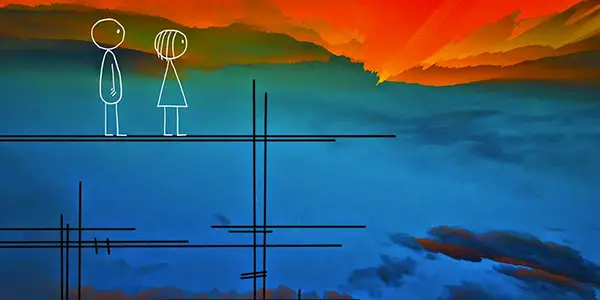
Hertzfeldt’s science fiction animated short film, World of Tomorrow (2015), earned him his second Academy Award nomination. This film proved once again that Hertzfeldt is a groundbreaking and visionary filmmaker. With this short, Hertzfeldt recorded his four-year-old niece (Winona Mae) while she was drawing and playing. He captured her natural questions and reactions, and used that audio as the basis for this film. Creating a film based on the audio recording of a child talking and playing is a fascinating challenge that resulted in one of the most unique short films to date. This also marks Hertzfeldt’s first foray into digital animation, which fits in well with the science fiction elements of the film. World of Tomorrow won 42 awards.
The main character of the film is Emily, and we see her as both an adult and as a child. The child is the original Emily, while the adult is her third-generation clone who is contacting her from 227 years in the future. Emily learns about new technologies from her future self and about how humans have explored different ways to achieve immortality, such as cloning. The clone shows Emily what her future is going to be like, but it is clear that she searched for her original self in order to view her memories. This film acts as a powerful commentary on memory, time, and what it means to be alive. It also features one of Hertzfeldt’s best lines of dialogue:
“Do not lose time on daily trivialities. Do not dwell on petty detail. For all of these things melt away and drift apart within the obscure traffic of time. Live well and live broadly. You are alive and living now. Now is the envy of all of the dead.”
World of Tomorrow shares similar themes with It’s Such a Beautiful Day, solidifying it as one of Hertzfeldt’s best and most essential films. In an interview with Hertzfeldt about the film’s sequel, Indiewire critic David Ehrlich refers to World of Tomorrow as the “best short film of the century”.
World of Tomorrow Episode Two: The Burden of Other People’s Thoughts (2017)
Two years later, Hertzfeldt produced a sequel to World of Tomorrow titled World of Tomorrow Episode Two: The Burden of Other People’s Thoughts (2017). Once again, Hertzfeldt based the film around audio of his niece drawing and playing. It’s just as bizarre and emotionally affecting as the original. Two words that can often describe Hertzfeldt’s best work are hilarious and heartbreaking. These words are also applicable to World of Tomorrow Episode Two.
This film is a fitting sequel as it expands upon the original film and includes even more clones of Emily. In this story, Emily meets an incomplete backup clone of her future self. Both World of Tomorrow and its sequel can be perceived as a critique of social media and the way we constantly document every aspect of our lives. This is perhaps most discernible from the sequel’s title, as “the burden of other people’s thoughts” can easily describe the feeling of scrolling through one’s Twitter feed or Instagram. World of Tomorrow Episode Two satirizes similar themes to the original, but packs in more ideas into its 22-minute runtime.
Conclusion
Don Hertzfeldt is one of today’s most groundbreaking animators and independent filmmakers. His films range from absurd slapstick humor to tragicomedies full of existential themes. Hertzfeldt’s signature minimalist animation style is part of what makes him stand out from other animators.
Although Hertzfeldt’s films consist of traditional stick figure drawings, his work is wildly creative and experimental. In fact, he’ll take more risks in a five-minute short film than some filmmakers will take in a two-hour feature. In an interview with Cut Print Film, Hertzfeldt articulates,
“Usually the more money that something takes to make, the less interesting it’s forced to become. If you go to a film festival and watch a bunch of features and then watch a bunch of shorts, you will almost always find that the shorts are where people are taking more risks and pushing more boundaries…simply because they have much less to lose.”
Hertzfeldt is an independent filmmaker in every sense of the word. He’s also a jack of all trades and will sometimes produce, direct, write, animate, photograph, compose music, record/mix sound, edit, and perform voice acting in his own films.
Some viewers might be turned off by the “childish” animation of his films, but upon closer inspection it is clear that this is the work of a brilliant artist who really has something to say. Hertzfeldt is truly an inspiration and proof that fancy equipment and a big budget aren’t always necessary. If you’ve got an idea that you want to share with the world sometimes all you need is a pen, paper, and a movie camera.
What’s your favorite Don Hertzfeldt film? Do you have a favorite animator? Share your answers in the comments section!
Does content like this matter to you?
Become a Member and support film journalism. Unlock access to all of Film Inquiry`s great articles. Join a community of like-minded readers who are passionate about cinema - get access to our private members Network, give back to independent filmmakers, and more.
Alexia (also known as Lexi) spends an alarming amount of time at the movies. When she's not working or writing, she's probably at the movies. When she's not at the movies, she's probably at home watching movies with her dog. Follow her on Letterboxd here: https://letterboxd.com/lexiamoriello












